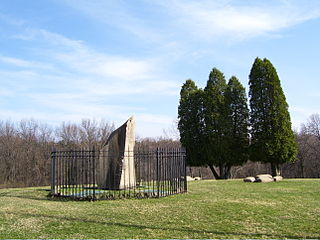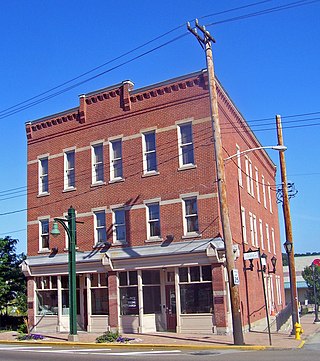
Adams County is a county in the Commonwealth of Pennsylvania. As of the 2020 census, the population was 103,852. Its county seat is Gettysburg. The county was created on January 22, 1800, from part of York County, and was named for the second President of the United States, John Adams. On July 1–3, 1863, a crucial battle of the American Civil War was fought near Gettysburg; Adams County as a result is a center of Civil War tourism.

The Rockville Bridge is the longest stone masonry arch railroad viaduct ever built, at 3,820 feet (1,160 m). It has 48 70-foot spans.

The Landis Valley Village & Farm Museum is a 100-acre living history museum located on the site of a former rural crossroads village in Lancaster, Pennsylvania. Founded by brothers Henry K. Landis and George Landis in 1925 and incorporated in 1941, it is now operated by the Pennsylvania Historical and Museum Commission. Its staff and volunteers collect, conserve, exhibit, and interpret Pennsylvania German material, culture, history and heritage from 1740 through 1940.

The Cambria Iron Company of Johnstown, Pennsylvania was a major 19th-century industrial producer of iron and steel founded in 1852. The company had the nation's largest steel foundry in the 1870s and was renamed the Cambria Steel Company in 1898. The company used many innovations in the steelmaking process, including those of William Kelly and Henry Bessemer. The company was acquired in 1923 by the Bethlehem Steel Company. The company's historic facilities, extending some 12 miles (19 km) along the Conemaugh and Little Conemaugh Rivers, are a National Historic Landmark District.
The Brandywine Battlefield Historic Site is a National Historical Landmark. The historic park is owned and operated by the Pennsylvania Historical and Museum Commission, on 52 acres (210,000 m2), near Chadds Ford, Delaware County, Pennsylvania in the United States.

Bushy Run Battlefield Park is a historical park that is operated by the Pennsylvania Historical and Museum Commission (PHMC) and the Bushy Run Battlefield Heritage Society on 218 acres (88 ha) in Penn Township, Westmoreland County, Pennsylvania in the United States. It was the site of the Battle of Bushy Run fought on August 5–6, 1763 during the Pontiac's Rebellion. The battle was a major victory for the British and enabled them to secure their control of the Ohio River Valley and what was to become the Northwest Territory. Bushy Run Battlefield Park was established as a Pennsylvania State Park in the 1920s and became a National Historic Landmark in 1960. The Visitor Center is open Wednesday through Saturday from 9:00 am until 5:00 pm, and Sunday from noon to 5:00 pm, during the months of May–October. The Visitor Center hosts a museum exhibit entitled, "The March to Bushy Run", a theater, a gift shop and battlefield tours. Bushy Run Battlefield Park is the only historic site or museum that deals exclusively with Pontiac's Rebellion. Battle reenactments are held annually on the first full weekend of August. The park is on Pennsylvania Route 993 near Harrison City and Jeannette.

The Bost Building, also known as Columbia Hotel, is located on East Eighth Avenue in Homestead, Pennsylvania, United States. Built just before the 1892 Homestead Strike, it was used as headquarters by the Amalgamated Association of Iron and Steel Workers and for reporters covering the confrontation. It is the only significant building associated with the strike that remains intact. It is a contributing property to the Homestead Historic District. It was declared a National Historic Landmark in 1999.

Moland House is an old stone farmhouse built around 1750, by John Moland, a Philadelphia and Bucks County lawyer. Although physically located in Hartsville, Warwick Township, Bucks County, Pennsylvania, its mailing address is in Warminster Township, Pennsylvania.

Fort Gaddis is the oldest known building in Fayette County, Pennsylvania and the second oldest log cabin in Western Pennsylvania. It is located 300 yards (270 m) east of old U.S. Route 119, near the Route 857 intersection in South Union Township, Fayette County, Pennsylvania. Fort Gaddis was built about 1769-74 by Colonel Thomas Gaddis who was in charge of the defense of the region, and his home was probably designated as a site for community meetings and shelter in times of emergency, hence the term "Fort Gaddis," probably a 19th-century appellation. It is a 1 1/2-story, 1-room log structure measuring 26 feet long and 20 feet wide.

The Claysville "S" Bridge is a historic S bridge in Washington County, Pennsylvania. The bridge is made of stone and was a part of the Cumberland Road and helped transport wagons and stagecoaches amid the American westward expansion in the early 19th century. It passes over Buffalo Creek.

Etna Furnace, also known as Mount Etna Furnace, Aetna Furnace, and Aetna Iron Works, is a historic iron furnace complex and national historic district located at Catharine Township, Blair County, Pennsylvania. The district includes five contributing buildings, six contributing sites, and two contributing structures. It encompasses a community developed around an iron furnace starting in 1805. Included in the district is the four-sided stone furnace (1808), gristmill site, canal locks, site of lock keeper's house, aqueduct, two small houses, the ruins of a charcoal house (1808), the foundation of a tally house, a blacksmith shop, bank barn, foundation of a boarding house, three family tenant house, two iron master' mansions, a store and paymaster's office, Methodist / Episcopal Church (1860), and cemetery with graves dating between 1832 and 1859.

The Swatara Furnace is a historic iron furnace and 200-acre national historic district located along Mill Creek, a tributary of the Swatara Creek in Pine Grove Township, Schuylkill County, Pennsylvania.

Brady's Bend Iron Company Furnaces is a set of historic blast furnaces and rolling mill located in Brady's Bend Township, Armstrong County, Pennsylvania. The furnaces are constructed of stone, with the first blown into production in 1840. A second furnace was added in 1845. They were hot blast furnaces powered by a 250-horsepower steam engine. The rolling mill was also powered by a 250-horsepower steam engine and went into production in January 1842. The furnaces and mill were established by the Great Western Iron Works in August 1839, and is considered by some the "Pittsburgh of the Middle 1800s" and "Cradle of the Iron and Steel Industry in America." It was known as the Brady's Bend Iron Company after 1844. The company was credited with manufacturing the first T-rails west of the Allegheny Mountains. The works closed in 1873.

The Reading Furnace Historic District is a national historic district that is located in Warwick Township and East Nantmeal Township, Chester County, Pennsylvania.
The Pennsylvania Heritage Foundation (PHF) is a non-profit partner of the Pennsylvania Historical and Museum Commission (PHMC), the official history agency of the Commonwealth of Pennsylvania. Established in 1983 to support the work of the PHMC in the preservation of Pennsylvania's history, the PHF is governed by a 15-member, volunteer board of directors, and operated on a day-to-day basis by two paid staff members who participate in administrative, community engagement, charitable giving and/or grants management activities.














